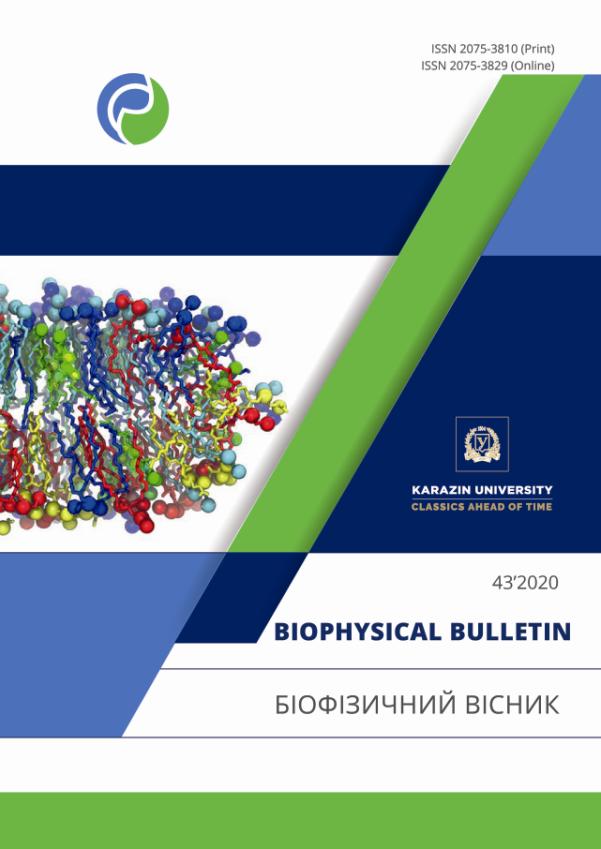Fluorescent properties of surface tissues of apples of different varieties in the green area of spectrum
Abstract
Background: Traditional methods of the content and composition of fruits nutrients determining are labor-intensive and material-intensive, require grinding and special processing of biological material. The fluorescent method is one of the most modern and promising. It allows determining physiological and metabolic parameters without plant tissues destruction. Therefore, the patterns and causes of differences identification of the different apple varieties fluorescent properties is an important task, which will solve the problem of non-invasive determination of the composition and content of useful substances in fruits.
Objectives: The determination of the surface tissues fluorescent properties in the green area of the fluorescence spectrum of apple varieties with different coloring of exocarp is the purpose of the work.
Materials and methods: The object of the study is apples of four popular winter varieties, close in maturity, with different coloring of exocarp. The method of fluorescence spectroscopy of the apples surface tissues was used. The excitation was made by a semiconductor laser with a wavelength of 405 nm and a power of 36 mW, operating in a continuous mode. The apples coloring is defined as the coordinate a of the CIELAB color mapping system.
Results: It was found that the wavelength of the maximum in the green area of the fluorescence spectrum of different apple varieties surface tissues differs by approximately 8–18 nm. At the same time, the difference of wavelengths of the maximum in the red area for different apple varieties does not exceed 5 nm. It was found that wavelength of the maximum in the green area of the fluorescence spectrum differs in different varieties in accordance with the coloring of the exocarp. If green color prevails in the exocarp coloring the fluorescence maximum in the green area has a longer wavelength, and if red prevails it has a shorter wavelength, while if yellow prevails, the wavelength occupies an intermediate position.
Conclusions: The pigment composition of the surface tissues of apples affects on their fluorescence in the green area of the spectrum. Possible reasons for the differences of the maximum wavelength in the green area of the fluorescence spectrum are the variability of flavonols composition depending on the apple variety and the influence of red pigments.
Downloads
References
Sinyutina SE, Romantsova SV, Savelyeva VYu. Extraction of flavonoides from plant material and study of their antioxidant properties. Tambov University Reports. Series: Natural and Technical Sciences. 2011;16(1):345–7. Available from: http://journals.tsutmb.ru/a8/upload/2018-december/temp.aed4b5ec6fb6a11c593eac7166b89c5a.pdf (In Russian)
Lysenko VS, Varduni TV, Soier VG, Krasnov VP. Plant chlorophyll fluorescence as an environmental stress characteristic: a theoretical basis of the method application. Fundamental research. 2013;(4):112–20. Available from: https://www.fundamental-research.ru/en/article/view?id=31109 (In Russian)
Fedotov YuV, Bullo OA, Belov МL, Gorodnichev VА. Experimental research into laser method for detecting plant stress. Herald of the Bauman Moscow State Technical University. Series Instrument Engineering. 2017;(2):21–32. http://doi.org/10.18698/0236-3933-2017-2-21-32 (In Russian)
Buschmann C, Langsdorf G, Lichtenthaler HK. Imaging of the blue green and red fluorescence emission of plants: An overview. Photosyntethica. 2000;38(4):483–91. https://doi.org/10.1023/A:1012440903014
Lideker W, Ginther K, Dahn HG, inventors; Deutsches Zentrum fur Luft-und Raumfahrt E.V., assignee. Fluorescence detection assembly for determination of significant vegetation parameters. United States patent US 6563122. 2003 May 13. https://doi.org/10.1023/A:1012440903014
Yagolnik EA, Muzafarov EN, Kim YuA, Tarahovsky YuS. The interaction of flavonol quercetin with collagen. Izvestiya TulGU. 2015;(2):121–32. Available from: https://patentscope.wipo.int/search/en/detail.jsf?docId=WO2000025114 (In Russian)
Bondariuk EV, Senchuk VV. The study of flavonols and their interaction with serum albumin by fluorescence analysis. Vestnik of Belarusian State University. Ser. 2, Chemistry. Biology. Geography. 2006;2(1):27–30. Available from: https://elib.bsu.by/bitstream/123456789/22406/1/27-30.pdf (In Russian)
Lichtenthaler HK, Schweiger J. Cell wall bound ferulic acid, the major substance of the blue-green fluorescence emission of plants. Journal of Plant Physiology. 1998;152(2-3):272–82. https://doi.org/10.1016/S0176-1617(98)80142-9
Lichtenthaler HK, Langsdorf G, Buschmann C. Multicolor fluorescence images and fluorescence ratio images of green apples at harvest and during storage. Israel Journal of Plant Sciences. 2012;60:97–106. https://doi.org/10.1560/ijps.60.1-2.97
Moskaliuk IV. The determination of jellying capacity of pectin substances of active peroxidase. Odes’kyi Politechnichnyi Universytet. Pratsi. 2009;1(31):177–9. Available from: http://pratsi.opu.ua/app/webroot/articles/1312459824.pdf (In Russian)
Tarun EI, Chudnovskaia EV. Inhibition of reactions of free radicals in the fenton system under the influence of flavonoids. Proceedings of Belarusian State University Physiological, biochemical and molecular basis for the functioning of biosystems. 2014;9(1):114–21. Available from: https://elib.bsu.by/bitstream/123456789/121737/1/114-121.pdf (In Russian)
Perfilova OV, Skripnikov YuG. Powder from fruit and vegetable cakes. Bulletin of Michurinsk State Agrarian University. 2006;(2):61–63. Available from: http://www.mgau.ru/sciense/journal/PDF_files/Vestnik_2_2006.pdf (In Russian)
Makarova NV, Valiulina DF, Bakharev VV. Use of summer varieties of apples as an antioxidant. Food Processing: Techniques and Technology. 2012;(2):70–5. Available from: http://fptt.ru/stories/archive/25/16.pdf (In Russian)
Rodikov SA. Chlorophyll fluorescence of fruit skin in blue and red ranges of spectrum. Bulletin of Michurinsk State Agrarian University. 2011;2(2):66–72. Available from: http://www.mgau.ru/sciense/journal/PDF_files/Vestnik_2_2011_2.pdf (In Russian)
Kim MS, Chen Y-R, Cho B-K, Chao K, Yang C-C, Lefcourt AM, et al. Hyperspectral reflectance and fluorescence line-scan imaging for online defect and fecal contamination inspection of apples. Sensing and instrumentation for food quality and safety. 2007;(1):151–9. https://doi.org/doi:10.1007/s11694-007-9017-x
Authors who publish with this journal agree to the following terms:
- Authors retain copyright and grant the journal right of first publication with the work simultaneously licensed under a Creative Commons Attribution License that allows others to share the work with an acknowledgement of the work's authorship and initial publication in this journal.
- Authors are able to enter into separate, additional contractual arrangements for the non-exclusive distribution of the journal's published version of the work (e.g., post it to an institutional repository or publish it in a book), with an acknowledgement of its initial publication in this journal.
- Authors are permitted and encouraged to post their work online (e.g., in institutional repositories or on their website) prior to and during the submission process, as it can lead to productive exchanges, as well as earlier and greater citation of published work (See The Effect of Open Access).





